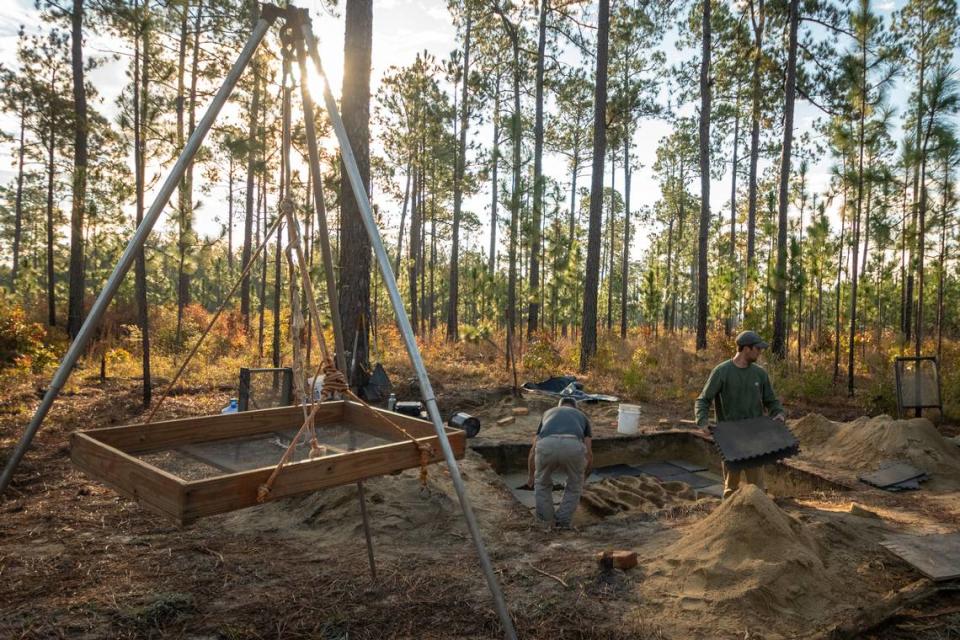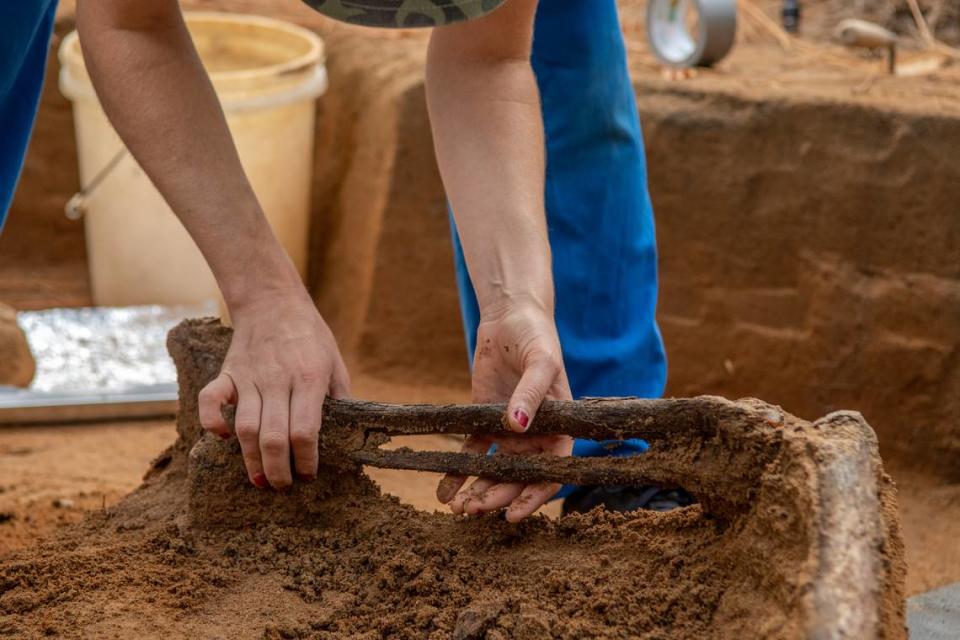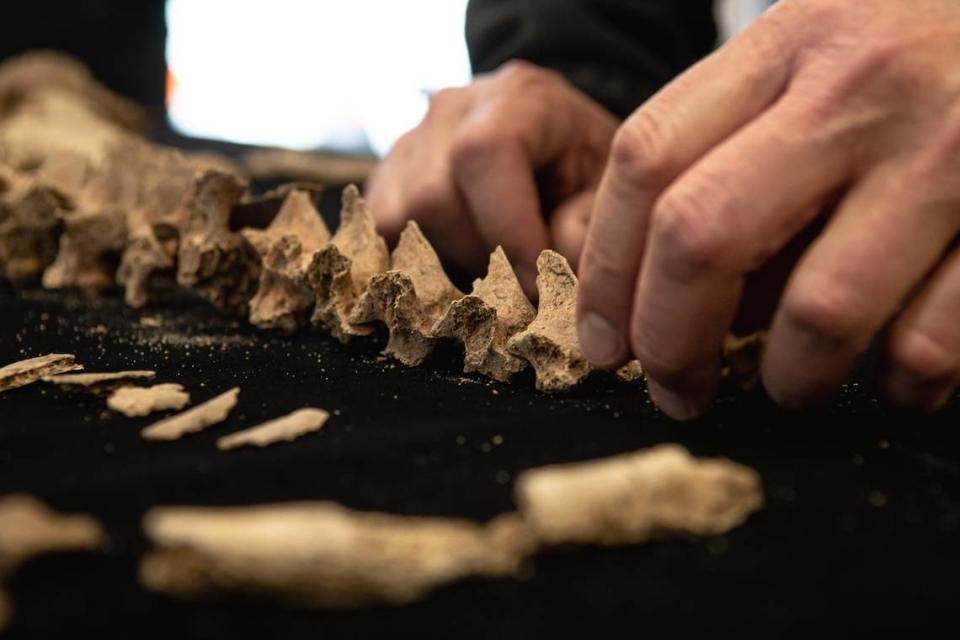They died in SC fighting for American independence. They’re finally getting a hero’s burial
It was no secret who was buried at Camden. Beneath pine straw and feet of soil were the bodies of men and boys. They had died by gun and bayonet, cannon and swords.
They were some of America’s first soldiers who, riddled with illness and eating nothing more than green corn and molasses, marched all night only to be cut down by British forces rampaging their way north from Charleston on the morning of Aug. 16, 1780 in the bloody Battle of Camden.
Suffering 900 casualties, the Americans fled in defeat. According to legend, some didn’t stop until they reached North Carolina. Their abandoned dead were thrown into communal graves, arms and legs intertwined, to lie in anonymity.
For more than two centuries, they did not rest peacefully. Wild hogs rooted through the shallow graves. The land was farmed and logged. Tractors drove over the graves, compressing dirt and clay and crushing bone that lay sometimes just inches below the surface.
For at least four decades, the site was known to private collectors who dug beneath the sand and clay to scoop up musket balls and prized buttons, ignoring the bones of the war dead.
But on Saturday, April 22, nearly 243 years after that bloody day, 14 of those soldiers will again be laid to rest following a three-day ceremony. Their discovery and secret excavation was the product of years of collaboration between the South Carolina Institute of Archaeology and Anthropology (SCIAA) and the South Carolina Battleground Preservation Trust.
“I hesitate to use superlatives,” said Doug Bostick, CEO of the South Carolina Battlefield Trust, which overseas the Camden battleground, “but (it’s) arguably the most significant Revolutionary War archaeological discovery in many decades.”
While it’s not the only recent significant discovery in Revolutionary War history— in August 2022, just months before the Camden discovery was announced, a dozen Hessian mercenaries who fought for the British were unearthed at the Red Banks in New Jersey — but it is the largest recent discovery of war dead who fought on the American side.
During the pandemic lockdowns, Jim Legg and Steven Smith from the SCIAA decided to follow up on persistent rumors from private collectors about the location of graves at Camden. Armed with metal detectors, they swept the battlefield every day until they got a reading. Digging down into the earth, Legg described finding a couple of buttons stamped with “USA,” issued to patriot soldiers.
Under the buttons, he found a femur. Expanding outward from the site, they began to find more bodies.
“As we got to a critical mass of six bodies, we thought, we need to do something with these people, because we need to protect them, and keep their graves from being desecrated,” Bostick said.
A team was soon assembled, including anthropologists and archaeologists from SCIAA, the University of South Carolina, the Richland County Coroner’s Office and the state Department of Natural Resources.
They worked under the proverbial cover of night — the battlefield was closed, ostensibly for renovations, while the dig was conducted to hide the site from looters.

As the group troweled, sifted and brushed away dirt, accompanied by a horde of volunteers, the six bodies became 14, spread across seven different graves. Among them were Continentals from Maryland and Delaware patriot militias, a member of a North Carolina loyalist militia and a towering Scottish highlander, believed to be a British shock troop from the feared 71st Regiment of Foot.
“It was exciting and a bit terrifying in the sense that we had a limited time and a limited number of people to work on the project and a limited amount of money,” said Smith of SCIAA.
By November, the excavation was complete. As each of the bodies was removed, a prayer was said, the box transporting them was draped with the flag of their nation, and toasts were offered — rum for the Americans, whiskey for the highlander.
The carefully cataloged remains were packed up and sent to the Richland County Coroner’s Office, where forensic anthropologists began the painstaking process of collecting data from the bones before preparing them for reinterment.
“In the past archeologists have excavated human burials and not put them back,” Smith said. “Our intent from the start was to rebury them. We never would have just dug them up for research purposes.”

The men, British and American alike, will be reburied with full British and American military honors Saturday following a three-day ceremony in Columbia and Camden, which will include a procession in U.S. Army Humvees through downtown Columba, past the State House and to Fort Jackson, a performance by the 282nd U.S. Army Band from Fort Jackson, and flyovers by a fighter squadron from Shaw Air Force Base and Apache helicopters from the South Carolina National Guard before the men are laid to rest in handmade coffins.
Asked why it was so important to go to such lengths to honor the ancient dead, Bostick turned even further back in history.
“The life of the dead is placed on the memories of the living,” said Bostick, quoting the Roman statesman Cicero. “It is incumbent upon us, particularly now, when things are so divisive in the United States, to reconnect with our founding story.”
Telling their stories
In a lab not far from Two Notch Road in Columbia, a team of anthropologists from the Richland County Coroner’s Office has become instrumental to telling that story.
Trained in using techniques of skeletal analysis to identify the deceased and solve homicides, the team has been called in to work some of the most challenging death cases around the state, including the 2019 murder of 5-year-old Naveah Adams of Sumter, whose body was thrown in a landfill.
“We’re involved in recovering and identifying remains on a day-to-day basis,” said Dr. Bill Stevens, head of the Richland County Coroner’s Anthropology Department, which analyzed the skeletons.

But with the 14 soldiers in their care, the anthropology team, which includes Dr. Madeline Atwell, a USC-trained biological anthropologist, and Rachel Baker, a deputy coroner, has also been challenged to answer not just how the soldiers died, but how they lived.
There’s an “opportunity here to advance the scholarship about what we know about people that fought in the American Revolution,” Bostick said.
Analysis of the skeletons has already shown that several of the dead soldiers were teenagers. One was found with a musket ball in his spine. But answering questions like the exact cause of death for every individual remains elusive — much of what could have been known from the remains has been lost to time and many of the skeletons were damaged by animals, the elements and careless farmers following their hasty burial.
Arriving at the point of analyzing 14 fragmented, heavily decomposed skeletons was an organizational feat that began at burial sites.
“You don’t just dig down and take this button out, or this musket ball, because it means something to us in relation to a bone or a body part,” Stevens said.
As the bodies were uncovered, photos and diagrams were made of the graves. Connective tissue was long gone so the most fragile bones were removed in blocks of soil, others were extracted individually and wrapped in foil and meticulously labeled and diagrammed.
Cleaning the bones for analysis is a slow, painstaking process. Working reverently, the team removed packed soil and fine webs of roots with brushes and tools resembling small scalpels carved from wood. The occasional spray of water is used to help compress the dirt, almost indistinguishable from bone, making it easier to scrape away.
On one afternoon in December, the team, assisted by John Fisher, an archaeologist from USC, was working gently on what appeared, to the untrained eye, to be a block of dirt when suddenly a thick slab fell away, exposing a remarkably preserved half of a skull. There were soft gasps as the anthropology team gathered around, examining the quality of the teeth and looking for signs of trauma that could offer clues as to how the individual died.
“These are the first straight lines we’ve seen in the skull,” Stevens said, pointing at barely perceptible grooves. “We know historically that these guys carried sabers and swords. It’s possibly our first sign of someone getting struck with a sword.”
Once the bones are cleaned, Atwell and Stevens laid out the skeletons to take measurements to help identify key characteristics like age, sex and race. The team also used X-rays to reveal Harris lines, thin bands of denser bone that can indicate juvenile malnutrition, disease or trauma.
Teeth have been extracted for DNA and isotopic analysis, which could offer a picture of the soldier’s health and ancestry. Historians and genealogical researchers are also working to learn about the units the soldiers served in and, along with the DNA, Bostick hopes that they may be able to find descendants of the deceased.
The goal of the Battleground Trust is to bring this information together with artifacts recovered from the graves and the wealth of historical information about the Revolutionary War, from weapons and diseases to society and camp life, will flesh out the human portrait of the soldiers who served in the war.
“It’s easy sometimes to write about these things in a dispassionate way,” Bostick said, “But there’s no way you can be removed from the reality of what you’re talking about, when you’ve stood over the body of soldiers in a grave that were just hurriedly buried and are six inches down.”
Honoring those who gave all
Certain themes keep coming up around the Camden project: Honor, sacrifice, duty, respect, privilege.
The opportunity for scholarship to advance our understanding and scholarship of the Revolutionary War is only a piece of Bostick’s mission at the Battleground Trust.
“To have the opportunity to respectfully lay these 14 bodies to rest the way they should have been in 1780 is just a mission and a great privilege,” Bostick said.
Outside of the pomp and circumstance of the Humvees, helicopters and fighter jets, the goal was to craft a funeral ceremony that would have been recognizable to the men who had been denied their burial rites.
The funeral will be conducted as a joint Anglican-Presbyterian service. The burial rites in the Anglican church haven’t changed since the 1500s, said the Rev. William Owens Jr., from the St. Mary Magdelene Anglican Church in Camden, who will perform the service alongside the Rev. Josie Holler from Williamsburg Presbyterian Church in Kingstree.
They also have prayer books written in the original Elizabethan English, meaning the service would be recognizable to the soldiers, according to Owens.
“Whether they were patriots or British soldiers is irrelevant to us. They deserve a decent burial,” Owens said.
By early April, the analysis on the remains was complete and the anthropologists at the coroner’s office prepared the soldiers for their reinterment.
Each soldier was placed in a coffin, specially built by Camden woodworker Philip Hultgren, who used long leaf pine wood salvaged from a 124-year-old former hardware store in downtown Camden. Examining the rings in the wood, Hultgren said he estimated that the trees began growing in the 1690s, almost a hundred years before the battle of Camden.
“It’s possible that the soldiers passed under or sat beneath these trees,” Hultgren said.
He hand planed the wood to remove all traces of machine marks and assembled the coffins using traditional, hand wrought iron nails. He then polished the wood with boiled linseed oil to give the coffins a warm luster.
“I wanted it to look like it was done with loving hands,” Hultgren said. “My thinking was, what would a family member have done for their loved one’s final internment?”
The soldiers will be transported from the coroner’s office to Camden by Humvees supplied by Fort Jackson. From there, they will lie in repose in the historic Kershaw Cornwallis House, near the battlefield.
On Saturday, they will be transported by horse drawn caissons, accompanied by an honor guard and the 282nd Army Band from Fort Jackson, before being reinterred in vaults, six feet below the ground where they were originally discarded.
How can you begin to repay the sacrifice of these men and boys? Hultgren asked. “You give what you can knowing that what you can give is inadequate.”
The schedule of events
Thursday, April 20: The 14 soldiers will be moved from Columbia to Camden on U.S. Army Humvees. The procession will move through Columbia’s downtown, arriving at the State Capitol at noon. Next, the procession will travel to Fort Jackson and then to the Kershaw Cornwallis House in Camden, where the soldiers will lie in repose from 6 p.m. until midnight.
Friday, April 21: The soldiers lie in repose from 7 p.m. until midnight at the Kershaw Cornwallis House in Camden.
Saturday, April 22: Funeral cortege from Historic Camden to Bethesda Presbyterian Church, 9 a.m.-10:30 a.m. Funeral service, 11 a.m. until noon. Burial honors ceremony, 3 p.m.
Source: scbattlegroundtrust.org

